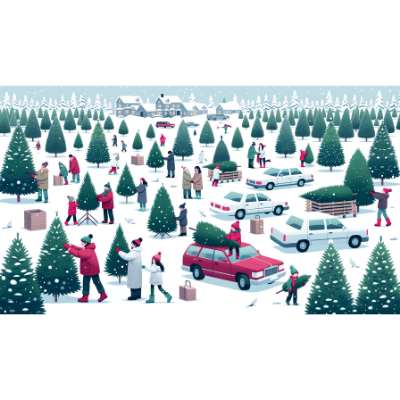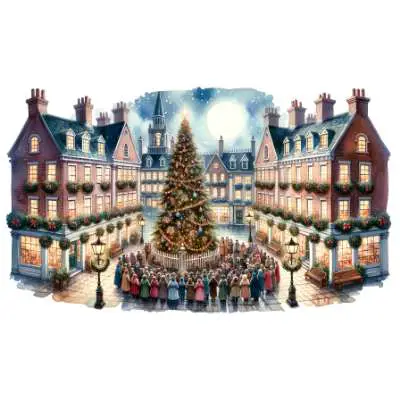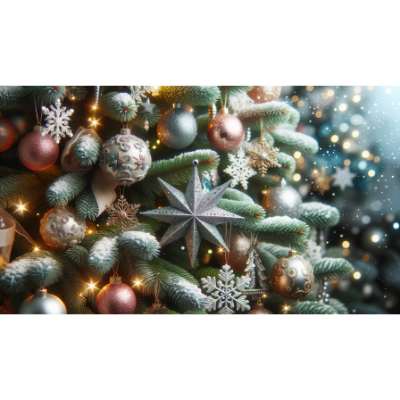Christmas trees, adorned with lights and ornaments, have become an iconic symbol of the holiday season. However, beneath the glittering decorations lies a darker history and hidden truths about their origins. Explore the pagan roots, the condemnation by clergy, and the environmental impact of these festive evergreens in this in-depth exploration of the dark truth about Christmas trees.
Pagan Origins of Christmas Trees
Historical Roots in Pagan Rituals The ancient Egyptians, Chinese, and Hebrews all had customs involving evergreen trees as symbols of eternal life. Pagan Europeans continued this tradition, decorating their homes with evergreens to ward off evil spirits. The Christmas tree’s roots delve deep into these ancient practices, merging pagan customs with Christian celebrations.
Evolution of the Christmas Tree from Pagan Customs German Lutherans embraced the Christmas tree in the 18th century, merging the paradise tree and Christmas pyramid. This fusion created the familiar image of a decorated evergreen that we know today. The transition from pagan rituals to a Christianized symbol marked a significant transformation in the cultural significance of Christmas trees.
Impact on Cultural and Religious Perceptions The adoption of Christmas trees into Christian celebrations sparked controversies, with some viewing them as pagan symbols. In the 1840s, many religious leaders condemned their use as a celebration of Christ, highlighting the ongoing tension between traditional practices and evolving religious beliefs.
Table of Contents
Ethical Concerns Surrounding the Christmas Tree Industry Beyond its historical roots, the Christmas tree industry has faced ethical challenges. The harvesting of trees has raised concerns about environmental sustainability and its impact on local communities. Examining the ethical implications of this industry adds another layer to the dark truth about Christmas trees.

Table: Environmental Impact of Christmas Trees
| Aspect | Impact |
|---|---|
| Deforestation | Clear-cutting for Christmas trees depletes forests. |
| Carbon Footprint | Transportation and disposal contribute to carbon emissions. |
| Local Ecosystems | Harvesting disrupts habitats and affects biodiversity. |
The Dark Truth About Christmas Pagan Symbolism
1840s Condemnation of Christmas Trees In the mid-19th century, Christmas trees faced scrutiny from clergy members and statesmen who viewed them as pagan symbols. The condemnation reflected a clash between traditional beliefs and emerging holiday customs. The tension surrounding the use of Christmas trees as a celebration of Christ underscores the evolving nature of holiday traditions.
Mistletoe’s Association with the Christmas Tree Mistletoe, a parasitical plant, adds another layer of symbolism to Christmas trees. Believed to have provided the wood for Christ’s cross, mistletoe’s association with Christmas trees ties back to both pagan and Christian narratives. Unraveling this connection reveals the intricate web of symbols woven into the holiday tradition.
Mythical Connection to Christ’s Cross The belief that mistletoe provided the wood for Christ’s cross is rooted in mythology. Exploring this myth sheds light on the intertwining of folklore and religious narratives in the history of Christmas trees. Understanding the symbolic elements embedded in the tradition deepens the appreciation of its cultural significance.
Environmental Impact of Christmas Tree Disposal Beyond the symbolism, the environmental impact of Christmas tree disposal raises concerns. The tradition of chopping down evergreen trees every December and disposing of them in January contributes to deforestation and waste. Unveiling the environmental consequences adds a somber dimension to the festive custom.
Alternatives to Traditional Christmas Trees Considering the ethical and environmental concerns, exploring alternatives to traditional Christmas trees becomes imperative. Potted trees, artificial trees, or even sustainable practices in Christmas tree farming offer viable options. This section provides practical alternatives for individuals seeking a more conscious approach to holiday celebrations.

Biblical Truths About Christmas Trees
Symbolism of the Christmas Tree in the Bible The incorporation of Christmas trees into religious celebrations brings forth questions about their biblical symbolism. The Christmas tree’s connection to the Garden of Eden, the religious feast day of Adam and Eve, and the symbolism of hanging wafers and candles all trace back to biblical narratives. Delving into these connections unveils the layers of religious significance embedded in the tradition.
Religious Feast Day of Adam and Eve and the Paradise Tree The choice of December 24, the religious feast day of Adam and Eve, for setting up the Christmas tree adds a unique religious dimension. The paradise tree, representing the Garden of Eden, becomes a focal point in understanding the interplay between biblical stories and holiday customs. Unraveling the religious roots enriches the understanding of Christmas tree traditions.
Use of Wafers and Candles as Christian Symbols The hanging of wafers on Christmas trees, symbolizing the Eucharistic host, and the use of candles as representations of Christ as the light of the world deepen the religious symbolism. Connecting these elements to Christian traditions enhances the appreciation of the Christmas tree’s role in religious celebrations. Understanding the layers of religious symbolism enriches the cultural tapestry of the holiday season.
Sustainable Practices in Christmas Tree Farming Balancing the religious and environmental aspects, exploring sustainable practices in Christmas tree farming becomes crucial. Implementing eco-friendly approaches, such as responsible harvesting and recycling programs, aligns with both biblical teachings and modern environmental ethics. This section provides practical insights for individuals seeking to merge religious traditions with sustainable practices.

Original Christmas Tree Slavery
Historical Context of Christmas Tree Harvesting Unraveling the historical context of Christmas tree harvesting reveals the industry’s evolution over time. From its roots in traditional practices to the commercialization of the holiday season, understanding the journey of Christmas tree harvesting provides insights into its cultural and economic significance.
Impact on Local Communities The Christmas tree industry’s impact extends beyond environmental concerns to local communities. Examining the socio-economic repercussions sheds light on the complexities of the industry. From employment opportunities to the influence on regional economies, the Christmas tree business has far-reaching effects that need exploration.
Ethical Concerns Surrounding the Christmas Tree Industry Ethical considerations in the Christmas tree industry encompass issues of fair labor practices, sustainability, and responsible resource management. This section delves into the ethical challenges faced by the industry, prompting readers to reflect on the broader implications of their holiday traditions. Understanding the ethical dimensions adds depth to the exploration of the dark truth about Christmas trees.
Practical Alternatives for Conscious Consumption In response to ethical concerns, individuals can adopt practical alternatives that align with conscious consumption. Supporting local, sustainable tree farms and opting for eco-friendly decorations are steps toward mitigating the ethical challenges associated with Christmas tree consumption. This section provides a guide for readers seeking to make informed choices during the holiday season.

The Truth About Christmas Trees
Environmental Impact of Christmas Tree Disposal The tradition of cutting down evergreen trees every December and discarding them in January has significant environmental consequences. Delving into the environmental impact reveals the scale of deforestation, waste, and carbon emissions associated with this widely accepted custom. Acknowledging the ecological footprint prompts a reconsideration of holiday traditions.
Alternatives to Traditional Christmas Trees As environmental consciousness grows, exploring alternatives to traditional Christmas trees becomes paramount. Potted trees, artificial trees, or even sustainable practices in Christmas tree farming offer viable options. This section provides practical alternatives for individuals seeking a more conscious approach to holiday celebrations.
Sustainable Practices in Christmas Tree Farming Balancing tradition with environmental responsibility, adopting sustainable practices in Christmas tree farming becomes imperative. From responsible harvesting to recycling initiatives, implementing eco-friendly approaches aligns with both tradition and modern environmental ethics. This section offers insights for individuals looking to merge holiday traditions with sustainable practices.
Impact on Local Communities Beyond environmental concerns, the impact of Christmas tree consumption on local communities deserves attention. Examining the socio-economic repercussions sheds light on the industry’s influence on regional economies. From employment opportunities to community dynamics, understanding the broader impact encourages a more nuanced perspective on the tradition.
Cultural Evolution of the Christmas Tree Tracing the cultural evolution of the Christmas tree reveals its transformation from a regional custom to a global phenomenon. From its German Lutheran roots to its adoption by the British royal family, the journey of the Christmas tree reflects changing cultural perceptions and traditions. Unveiling this evolution adds depth to the understanding of the cultural significance of Christmas trees.
Christmas Tree Syndrome
Increased Mold Production in Warmer Climates Bringing Christmas trees indoors has unintended consequences, notably the increased production of mold in warmer climates. Understanding the science behind Christmas tree syndrome sheds light on the potential health risks associated with this beloved tradition. Acknowledging the impact on indoor air quality prompts considerations for individuals with respiratory conditions.
Allergens Associated with Christmas Trees While pine pollen is not a major concern for allergy sufferers, other allergens can be introduced through Christmas trees. Grass pollen contamination during tree growth and other environmental factors contribute to potential health risks. This section explores the allergens associated with Christmas trees, offering insights for individuals seeking a healthier holiday environment.
Environmental Impact of Christmas Tree Disposal Beyond health considerations, the environmental impact of Christmas tree disposal adds another layer to the dark truth about this festive tradition. Exploring the consequences of chopping down trees annually and the associated waste prompts reflection on sustainable alternatives. The intersection of health and environmental concerns encourages a more holistic approach to holiday celebrations.
Practical Alternatives for Individuals with Allergies Individuals with allergies can adopt practical alternatives to mitigate health risks during the holiday season. From choosing hypoallergenic tree varieties to exploring alternative decorations, this section provides actionable steps for creating a festive environment without compromising health. Empowering individuals with information promotes a safer and enjoyable holiday experience.
Cultural Variations in Christmas Tree Customs While Christmas tree traditions are widespread, variations exist across cultures. Exploring how different regions celebrate with Christmas trees reveals unique customs and practices. From Sweden’s Saint Lucia celebration to Russia’s New Year’s tree tradition, this section showcases the diversity of Christmas tree customs globally. Embracing cultural variations enriches the understanding of this universal holiday symbol.
Christmas Tree Spiritual Meaning
Evolution of Christmas Tree Symbolism The symbolism of Christmas trees has evolved over centuries, from ancient pagan rituals to Christian celebrations. Tracing this evolution reveals the layers of meaning woven into the tradition. The Christmas tree’s journey from a pagan symbol to a Christian icon reflects the dynamic nature of cultural symbols.
Secularization of Christmas Tree Traditions While the Christmas tree’s roots are deeply intertwined with religious symbolism, its modern use has largely become secular. Exploring the secularization of Christmas tree traditions sheds light on how the custom has transcended its religious origins to become a widely embraced cultural symbol. The dual nature of the Christmas tree as both a religious and secular icon adds complexity to its significance.
Cultural Variations in Christmas Tree Customs Christmas tree customs vary across cultures, adding unique layers of meaning to this festive tradition. From Catalonia’s Tió de Nadal log tradition to Greece’s transition from Christmas boats to trees, cultural variations reflect diverse interpretations of the Christmas tree’s spiritual meaning. Embracing this diversity enriches the spiritual tapestry of the holiday season.
Practical Alternatives for a Spiritual Celebration Individuals seeking a more spiritually meaningful celebration can explore practical alternatives to traditional Christmas trees. From incorporating religious symbols into decorations to participating in spiritual rituals, this section offers guidance for infusing a deeper spiritual dimension into holiday traditions. Connecting with the spiritual roots of Christmas trees enhances the overall meaning of the festive season.
Cultural Evolution of Christmas Tree Symbolism The cultural evolution of Christmas tree symbolism highlights its adaptability and resonance across different communities. From its origins in medieval plays about Adam and Eve to its adoption by the British royal family, the Christmas tree has transformed into a universally recognized symbol. Unveiling this cultural evolution deepens the appreciation of the spiritual meaning embedded in the tradition.
Unusual Christmas Tree Traditions Around the World
Saint Lucia Celebration in Gothenburg, Sweden In Gothenburg, Sweden, the arrival of Saint Lucia is celebrated with a unique blend of scents and illuminations. Exploring this tradition unveils the charming festivities and cultural significance attached to Christmas trees in Scandinavian customs.
Russia’s New Year’s Trees Tradition Russia’s tradition of New Year’s trees, or yolka, emerged in the 1920s amidst a ban on Christmas trees after the Russian Revolution. Delving into this historical context provides insights into how Christmas tree traditions adapted to changing political landscapes.
Christmas Tree Traditions in Antarctica Even in the icy landscapes of Antarctica, Christmas tree traditions have left their mark. From tying a spruce tree to a U.S. Navy expedition mast in 1946 to the more recent tradition at the U.S. Amundsen-Scott South Pole Station, exploring these unusual customs showcases the universality of the Christmas tree.
Greece’s Transition from Christmas Boats to Trees In Greece, Christmas boats were once the focal point of celebrations in honor of St. Nicholas. Understanding the transition from boats to trees sheds light on the cultural shifts that have shaped Christmas traditions in different regions.
St. Knut’s Day Celebration in Scandinavia Since the 17th century, Scandinavian families have celebrated St. Knut’s Day by raiding their Christmas trees for sweets before discarding them. Unraveling this unique tradition offers a glimpse into the playful and sometimes whimsical aspects of Christmas tree customs.
Catalonia’s Tió de Nadal Log Tradition Catalonia’s Tió de Nadal, a hollow log tradition, involves a peculiar ritual of caring for the log in the weeks leading up to Christmas, only to beat it with sticks on Christmas Day. The origin of this ritual remains mysterious, adding an element of intrigue to the rich tapestry of Christmas tree customs.
Conclusion
In conclusion, the dark truth about Christmas trees encompasses a complex tapestry of pagan origins, religious symbolism, environmental impact, and cultural evolution. From the condemnation by clergy to ethical concerns in the industry, this exploration sheds light on the multifaceted nature of a seemingly festive tradition. As we navigate the holiday season, understanding the hidden layers of Christmas tree customs allows for a more informed and conscious celebration. Whether rooted in religious traditions, environmental considerations, or cultural diversity, the Christmas tree remains a symbol that reflects the evolving spirit of the season.
© 2024 Lotusmagus.com. All rights reserved. This content is protected by copyright. Visit Lotusmagus.com for more information.

